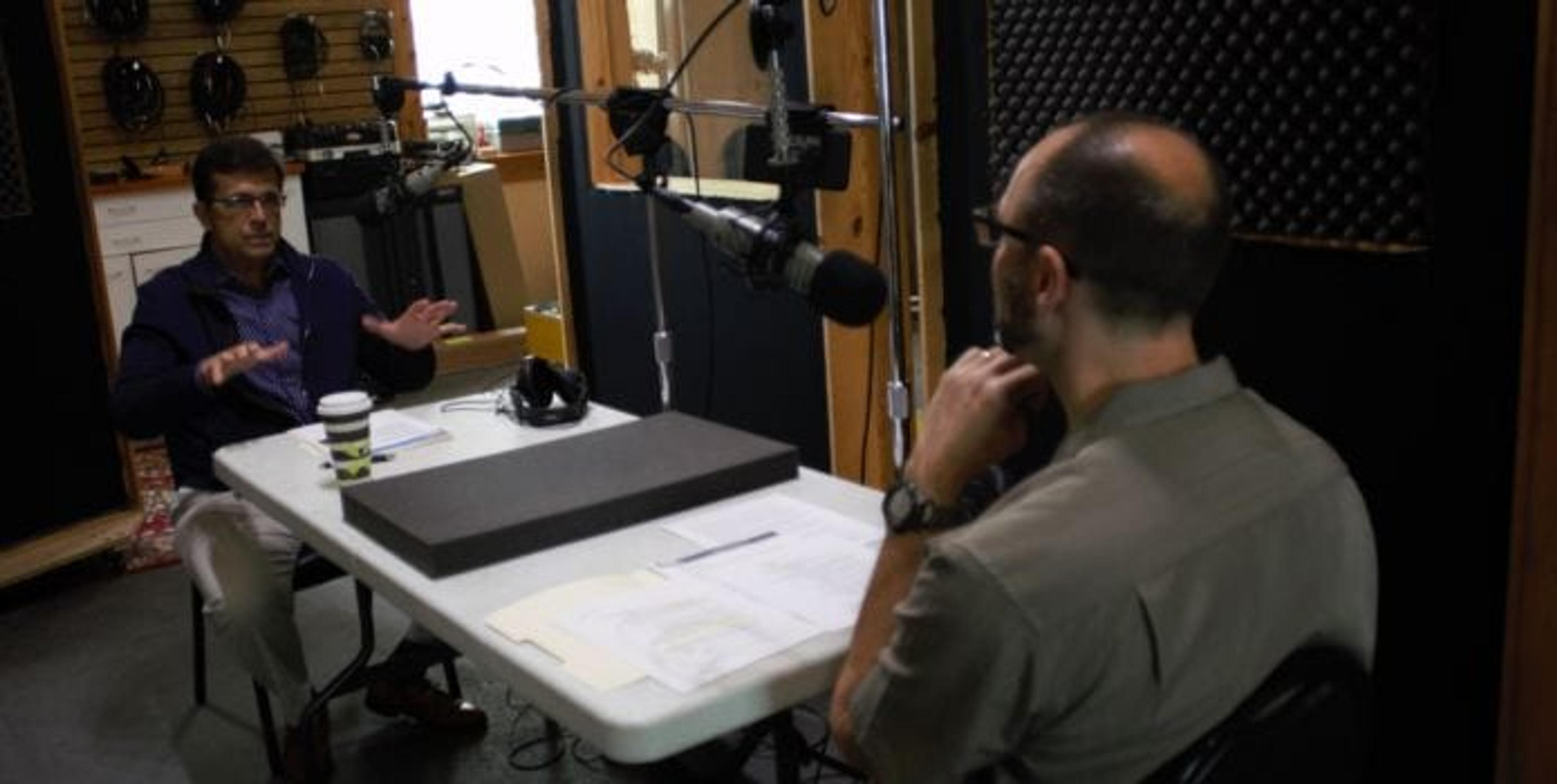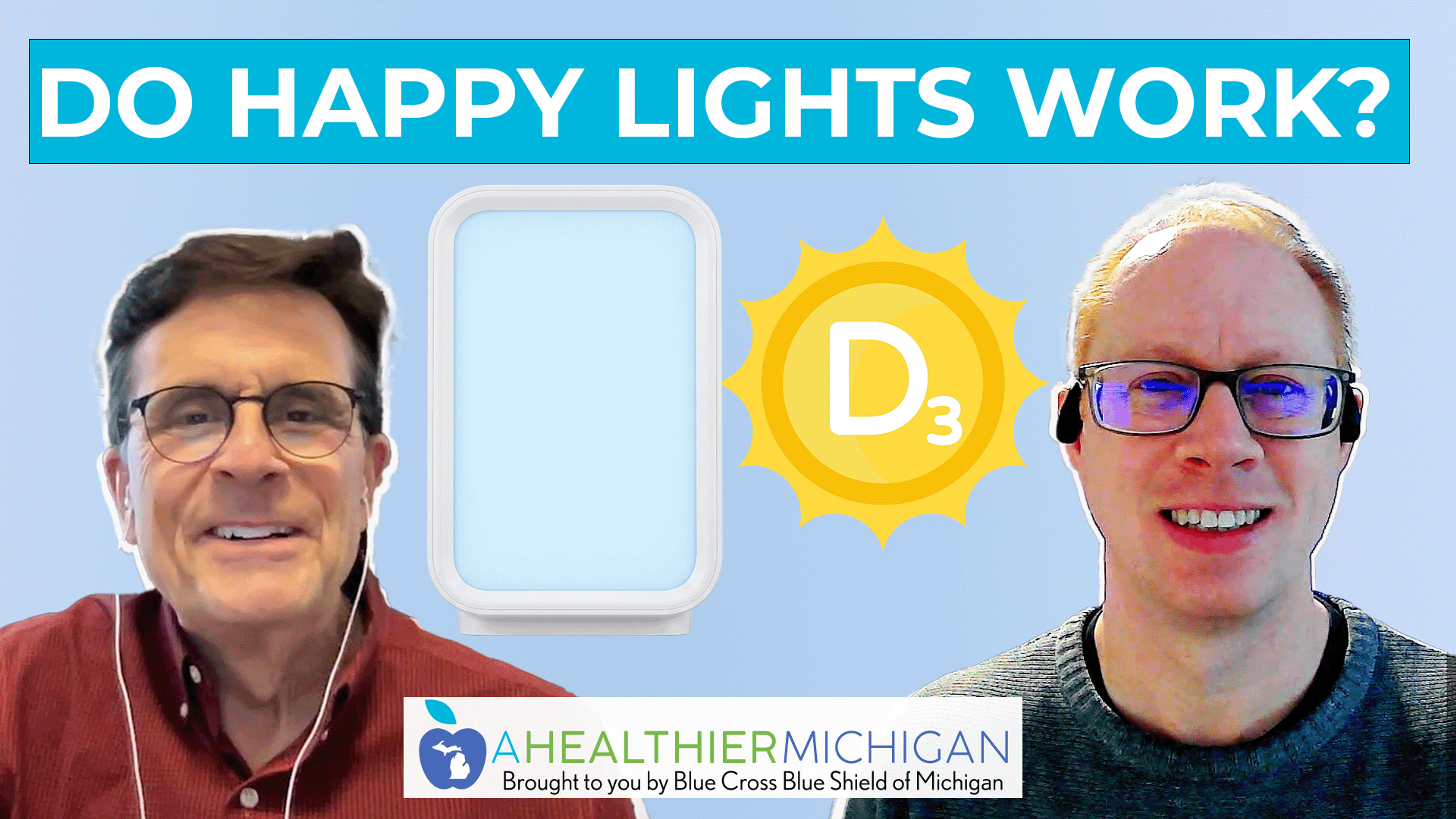Guided Progressive Muscle Relaxation
| 1 min read

00:00
00:00
About the Show
On this episode, Chuck Gaidica and Dr. Duane DiFranco discuss progressive muscle relaxation and how to incorporate it into your daily life.
“With progressive muscle relaxation, you could do it anywhere. You probably want to do it in private. Otherwise, people might worry about you. You’re going to be making some facial grimacing… When you tense your arms, that’s going to look a little funny. You might shake a little bit. It’s a bit of a physical exercise.” – Dr. Duane DiFranco
In this episode of A Healthier Michigan Podcast, we explore:
- The difference between mental and physiological stress response.
- What is progressive muscle relaxation?
- How it compares to deep breathing and guided imagery.
- A sample progressive muscle relaxation exercise.
- What stress reduction technique works best for you?
- A list of authors and titles to aid you during the process:
- 10 Minutes to Relax by Paul Overman (iTunes, Amazon)
- Stop Panic – Guided Imagery Series by Marianne Zaugg,
- Stress Stop: Stress Management Training by Stuart McCalley, M.D.
- The Relaxation and Stress Reduction Workbook by Matthew McKay, Martha Davis, etc.
Transcript
Chuck: This is A Healthier Michigan Podcast, episode 18. Coming up, we discuss how we can all use progressive muscle relaxation to reduce our stress.
Chuck: Welcome to A Healthier Michigan Podcast, the podcast dedicated to navigating how we can improve our health and well-being through small, healthy habits, and we can start implementing those right now. I’ve been pleased to be your host of all 18 of these episodes. I’m Chuck Gaidica. Each week we sit down with a certified health expert from Blue Cross Blue Shield of Michigan. We do a dive into topics like nutrition and well-being and stress reduction.
Chuck: I hope you’ve enjoyed these as much as I have because these 18 episodes, I’ve learned so much, I’ve really been able to put a lot into practice, and as we learn with Dr. Duane DiFranco, that’s part of this deal of practice makes perfect. Dr. DiFranco is back with us. He’s a board-certified psychiatrist. I’ll get it right. I always want to say something else, and I get mixed up when I see that word, doctor. I don’t-
Dr. DiFranco: But you get it right every single time.
Chuck: Well, on the second try.
Dr. DiFranco: Yeah.
Chuck: He’s currently Senior Medical Director at Blue Care Network of Michigan, graduate of Notre Dame University. Also went to U of M. So good to have you with us.
Dr. DiFranco: Good to be here. Thank you.
Chuck: Yeah, so you’ve taught us so much in the past couple podcasts. Episode 16, 17 will be similar to this. These are, I think, episodes that could be played over and over again for folks that are looking for stress reduction today, dealing with progressive muscle relaxation. Explain what that is for mere mortals like me.
Dr. DiFranco: So much of a part of a person’s response to a stressful stimulus, their stress response, what they call their being stressed out, is physiologic. Part of that is elevated heart rate, elevated blood pressure, those things you don’t know until you check them, but everyone who has dealt with stress and whose stress response contains an important physiologic component knows that stress leads to muscle tension, usually in the jaw, upper back, shoulders-
Chuck: Mine is shoulders, neck, back of my head. Yeah.
Dr. DiFranco: Classic. Yeah, and that leads to headache. It leads to fatigue, and it sets up one of those vicious circles we’ve talked about in previous podcasts that are so much a part of the unfortunate components of stress where the stress causes muscle tension, muscle tension causes pain, pain is stressful, and now I’m at the beginning of the cascade. So in progressive muscle relaxation is the third of three types of relaxation exercises that are an important part of stress reduction therapy. We did the first one, deep breathing, kind of the core exercise, breathing deeply and regularly as a part of each of the other two exercises, guided imagery, which we did last time, and today we’ll take folks through a progressive muscle relaxation exercise.
Chuck: So is there anything that we’re going to do that’s going to be so much different? This seems like something we would understand right away, where the imagery was a little different. The breathing, it seems intuitive because we have to do it all the time to live. Is this different than what we would assume it is in any way?
Dr. DiFranco: It is a little different than the other two.
Chuck: It is.
Dr. DiFranco: I would say this is different in some ways. Guided imagery is also a little different too, because with progressive muscle relaxation, which we’re going to do today, and with deep breathing, you listen to me, you listen to one of the other professionals, you can get iTunes episodes on, and they take you through the exercise, but then you learn them and you can do them on your own without your iPod or your phone with you to listen. Guided imagery, you need to listen through. Progressive muscle relaxation is a little different. It’s not so much as relaxing, quite frankly, as the other two in the moment because part of progressive muscle relaxation actually has to do with tensing the muscles first.
Chuck: Gotcha. Can I do this in an office? I mean, can I unplug from what I’m doing right now or do I have to be in this peaceful either sitting or reclined space?
Dr. DiFranco: So with progressive muscle relaxation, you could do it anywhere. You probably want to do it in private. Otherwise, people might worry about you. You’re going to be making some facial grimacing. You’re going to be … When you tense your arms, that’s going to look a little funny. You might shake a little bit. It’s a bit of a physical exercise. It’s not so much of a mind exercise the way that guided imagery was.
Chuck: Gotcha.
Dr. DiFranco: And in fact, with respect to that aspect about it, the fact that it’s a bit of a physical exercise, it’s so much so that folks who have musculoskeletal conditions, maybe some hip problems, knee problems, might want to be careful about doing it. Just be wise. Obviously, as always, if anything you do causes you pain, you should stop, and this is a physical enough exercise that people should be warned to do that. And although doing this exercise every day over a long period of time can reduce your blood pressure, reduce your heart rate, unlike deep breathing and guided imagery, this can actually, in the short term, get your heart rate going because we’re going to be tensing some muscles just as tight as we can get them.
Chuck: Okay. So we’ve got the cautions. I’m anticipating, though, what I’m going to learn today. So people can’t see me, but I’m getting in my seated chair position.
Dr. DiFranco: Good.
Chuck: Doctor.
Dr. DiFranco: I’ll take you through and take our listeners through, and then just as you said, they can replay this whenever they feel the benefit.
Dr. DiFranco: All right.
Dr. DiFranco: So before we begin, just take a moment. Get as comfortable as you can. You may want to, if you’re at home and in private, loosen your belt, unbutton your shirt collar, maybe take your shoes off. You can lie down or sit to do this exercise. If you sit, sit with your feet flat on the floor, your back comfortably upright, supported by your chair. Place your hands open and palms down on your thighs, and let’s begin.
Dr. DiFranco: I want you to begin by just placing a hand on your belly and by breathing deeply. Close your eyes. Now take a deep, cleansing breath in. Hold it at the top of your breath for three, two, one seconds, and exhale. Relax your abdomen. Take a few moments and just breathe, nice and slow, making each breath in and each breath out about five seconds long. As you relax and breathe evenly, deeply, slowly, imagine the air going all the way into your waist with each breath in. Feel how your belly rises when you take air in, air that sustains you and feeds you. With each breath you take in, you are being filled with life and with calm energy. With each breath out, feel tension leaving your body.
Dr. DiFranco: Now, we will focus on one body area at a time, tensing all the muscles in that area as tight as we can possibly get them while we continue to breathe. Then we will hold that tension and our breath for five seconds, and before releasing it all completely and returning again to relaxed breathing. Continue to breathe deeply and evenly as you begin now first to tighten the muscles of your face. Tighten your face into a squinting frown. Bring your eyebrows as tightly together as you can make them. Raise your cheeks as high as you can get them. Tighten the muscles of your forehead and neck. Try to keep the other muscles of your body relaxed, tightening only those muscles in your face and head.
Dr. DiFranco: And now, with your face, head, and neck as tight as they can be, take a deep breath in and hold it for five, four, three, two, and breathe out and relax your face. Relax your forehead and eyebrows. Let your jaw drop. While you continue to breathe deeply, slowly, evenly, feel your face and neck relax further as each breath out carries away all the tension you no longer need.
Dr. DiFranco: And now, tighten your hands into fists. Continue to breathe deeply and slowly. Tighten the muscles of your arms, your shoulders, your chest, and upper back. Make your fists, arms, chest, and upper back as tight as they can be. Take a deep breath in and hold it for five, four, three, two, and release. Breathe out and relax. Take a deep, cleansing breath now, pausing a second before you breathe out. Now, as the tension continues to leave your shoulders, your chest, your jaw, your face, and your arms, resume peaceful, deep, even breathing. You may want to wiggle your shoulders just a bit. Your face is relaxed, your jaw is relaxed, your shoulders and arms are relaxed.
Dr. DiFranco: You may feel other parts of your body also relaxing. Your head may want to fall gently to the side or down or back. Let it. Relax. You may feel warmth or other new sensations. That’s just fine. With each breath out, feel more tension leave your body and evaporate. Now, trying to leave all other muscles as relaxed as they can be, tense the muscles in your stomach, your lower back, and buttocks. Focus your attention there, keeping your forehead, your face, jaw, chest, and upper back relaxed. As you continue to breathe deeply and evenly, now tighten the muscles in your thighs, calves, and feet. Your abdomen, buttocks, thighs, calves, and feet are as tight as they can be, and the rest of your body is relaxed. Holding that tension, take a deep breath in and hold it for five, four, three, two, and release.
Dr. DiFranco: Take a few deep, slow breaths now, filling your lungs as full as they can be without straining. As you empty them, feel the last bits of unnecessary tension leave your body. Relax your forehead more deeply. Relax your eyebrows and your jaw more deeply. Breathe deeply, slowly, evenly. Notice your abdomen relax more completely. Notice your shoulders falling into even greater relaxation. Your arms, back, and legs are relaxing even more completely, more comfortably. Perhaps you notice a heaviness and a warmth spreading through your body. Relax and breathe deeply, slowly, and gently. Linger here for a while. When you open your eyes and rise, you will feel refreshed and calm, and you can take this comfort with you wherever you go today.
Chuck: So I was able to participate with most of this one.
Dr. DiFranco: Yeah.
Chuck: And the only reason I say most is because when you asked me to relax my neck and my head and let it lay to whatever side, I was afraid I would start drooling or something, you know? So I understand now why you can’t just do this in your cubicle because you are grimacing, and it would look like you’re really maybe even more tense than you started.
Dr. DiFranco: You don’t need the audio once you’ve got it down. In that sense, you can do it anywhere, but unless you’re someone who’s fortunate enough to work with an office where you can shut the door and not be disturbed and draw the blinds or something, yeah, it’s not that sort of thing. Now, deep breathing, like I said two podcasts ago, middle of a meeting, you know-
Chuck: Is there a priority list you can assign to these techniques? I know its context, so whatever someone’s issues are may be different, but if we look at deep breathing, guided imagery, and today, the muscle relaxation. Is there … If you said there’s a go-to of all three of these podcasts, episode 16, 17, and today, 18, is there such a thing, or it’s really experimenting with what works for you?
Dr. DiFranco: Great question. So in a certain sense, I would say whatever works best for you, and different people are going to be more or less well suited to one. However, there is a hierarchy that I would recommend that I think works for most people, and that is deep breathing at the top, partly because, as you’ve noticed as we’ve gone through guided imagery and now progressive muscle relaxation, that deep breathing, those principles, that technique is a part of each of these others.
Chuck: It’s the thread through all of them. Yeah.
Dr. DiFranco: So in that sense, it’s more fundamental, and also because it can be done anywhere. And the more we practice it, I’m going to sit down for 10 minutes, I’m going to deep breathe, I’m going to take myself through the exercise, then it becomes that habit after time, so I begin breathing more naturally during the day and I can remind myself. I’m in a meeting, I’m nervous, and I’m breathing shallow. Okay, I’m going to slow that down. And remember what we said before … I think we said this. You’re walking down the street. If you’re feeling unhappy, you’re not smiling.
Chuck: Right.
Dr. DiFranco: If you smile, and we all know that feelings cause facial expressions. It’s also true, though, that facial expressions cause feelings. So it is with deep breathing. If you’re nervous, and therefore breathing shallow and tight, that’s going to make you more nervous. If you can consciously force yourself to breathe more slowly and evenly, then you become less nervous. Maybe just a tad, but maybe that’s all you need is to take the edge off. So I would say deep breathing, number one. Guided imagery I might sort of put towards the end just because you really do need to sit and listen, and so therefore you have to have audio equipment with you.
Chuck: Kids can’t be running around, yeah.
Dr. DiFranco: Kids can’t … Exactly. Yup. Good point, good point.
Chuck: So the other thing that I’m taking from this, and while it is a little harder with the muscle relaxation, Cindy pointed this out on one of the previous episodes. It’s okay to unplug for a while because guess what? Everything will work again tomorrow when you plug it back in. In this case, the point is you can unplug the vacuum for a minute. Close your office door, just have a little deep breathing exercise before you walk into that big meeting that’s giving you some kind of anxiety, because when you plug back in 60 seconds later, you’re going to go. It’s okay. Just calm down for a minute.
Dr. DiFranco: Great point. And I would encourage people along with that, Chuck, to choose at least one of these exercises. Do it right now. You know, we talked about the positive psychology exercises of taking two minutes to thank someone in writing for something they’ve done recently for you, writing down a meaningful experience. Just taking two minutes to write a couple of paragraphs, something that happened to you recently, or writing down something that you’re thankful for. We talked about how writing it down is important, and about how it being specific and recent is important, and then we went through each of these three deep relaxation exercises, deep breathing, guided imagery, progressive muscle relaxation.
Dr. DiFranco: I would just ask listeners, choose one of these things and decide, when in the next 24 hours are you going to do it? If you do that, you’re much more likely to start, and if you start, you’re much more likely to keep up with it, and if you keep up with it, you’re much more likely to help yourself.
Chuck: It’s like you just wrote a prescription. It’s more than a call to action. You have to start to begin.
Dr. DiFranco: Exactly.
Chuck: Let’s start something, and also take the doctor’s advice about this idea of making it a habit. After three, three and a half weeks, these things become healthful and they become a matter of habit. Anything else you want to leave us with, links or otherwise, or we can post everything on our website?
Dr. DiFranco: I mentioned them in the last podcast, some of the folks I think who do a great job with exercises like these. Paul Overman, 10 Minutes to Relax, Lee Riley, Marianne Zaugg all have a series of relaxation techniques you can buy on Amazon or iTunes.
Chuck: Well, I would highly recommend that you go back and listen now if you’re looking to put these into practice. Dr. Duane DiFranco has been so gracious to help us with these three podcast episodes, 16, 17 and 18. You can replay them. Once you get the hang of it, if you don’t need them again, you’re all set for that period of time. What a joy working with you.
Dr. DiFranco: You too. Thank you.
Chuck: It’s just been really helpful, and I’ve learned a lot, and I can put things into practice today.
Dr. DiFranco: Here’s hoping we’re helping a lot of folks out there.
Chuck: Yeah.
Dr. DiFranco: That’s the goal.
Chuck: That’s for sure. Thanks so much, Duane. Thank you for listening to A Healthier Michigan Podcast. It’s brought to you by Blue Cross Blue Shield of Michigan. If you like the show, check us out, and again, we’ve got all 18 podcast episodes from season one posted for you at ahealthiermichigan.org/podcast, and whenever we’ve mentioned a link or one of our experts has mentioned a link, they will be posted there as well. You can leave reviews. You can leave ratings on iTunes and Stitcher. New episodes are always available on your smartphone or tablet. All you have to do is subscribe, Apple Podcast, Stitcher, your favorite podcast app.
Chuck: As I mentioned, this has been season one. There’s talk, I don’t know, of a season two. We hope that’s the case because I can’t imagine a better one-stop shop than Blue Cross Blue Shield of Michigan to find the experts to help us all journey through life together because there’s so much that’s going on that can be distracting in our lives. We hope that you’ve enjoyed these A Healthier Michigan Podcast. So thank you so much for joining us, and we will hope to see you as we head into the New Year of 2019. Be healthful, be well, be safe. Thanks for joining us.





